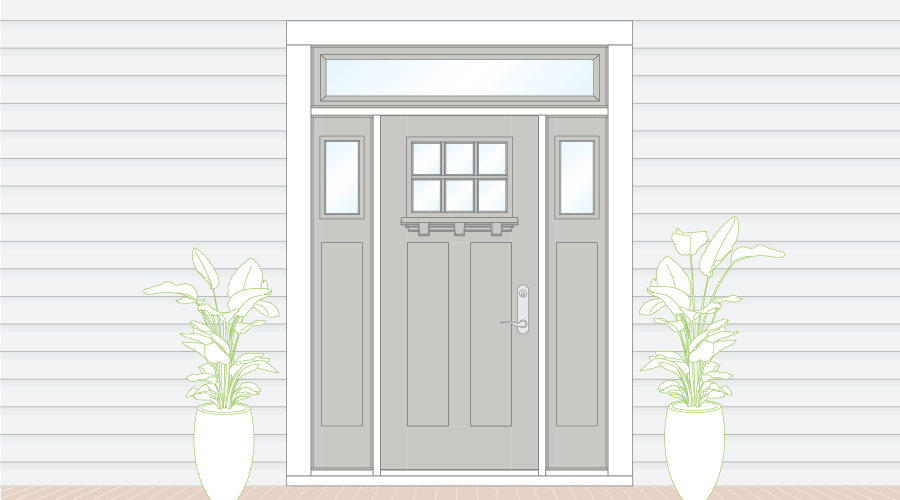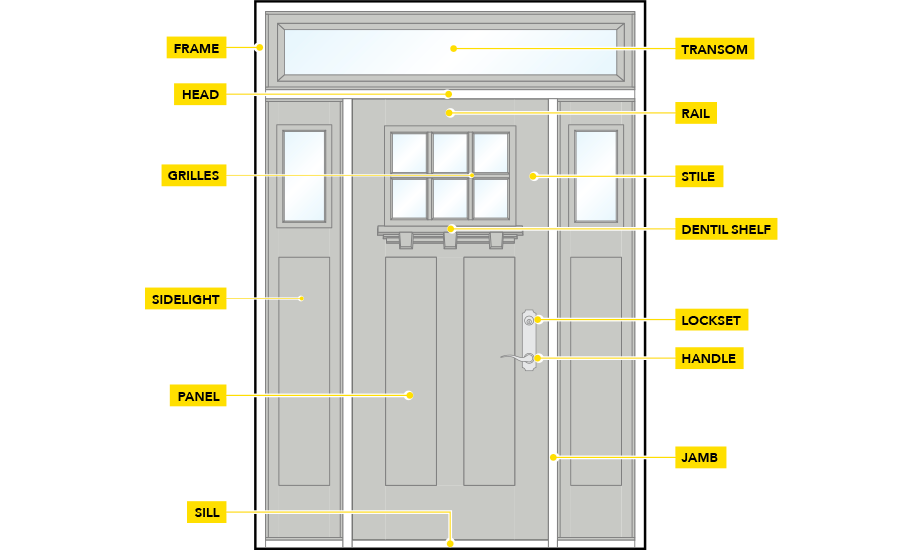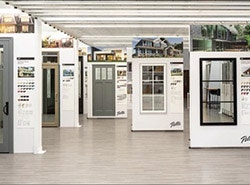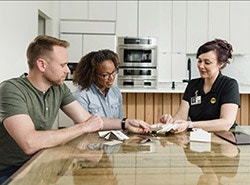Parts of a Door: Front Door Anatomy 101
Learn about the parts that make up your front door.

If you want to increase your home’s curb appeal, choosing a new front door can be one of the best ways to see an impact. Replacing your front door, or choosing one in a new construction project, is an easy process, but it’s helpful to know the technical terms. Whether you’re looking to learn more about the parts of a window, parts of a patio door or parts of an entry door, in this article, we will define the common parts of a door to make it easier to talk to building professionals.

Parts of a Door
Doorway
A doorway is one of the easiest parts of a door to see. It is the opening that you walk through to enter a home or go from one room to another.
Door Frame
A door frame is what supports the door and consists of the head, jamb and sill. It is commonly made from wood, aluminum or steel.the frame and sits flat against the floor.
Head or Door Head
The door head is a horizontal section of the door frame that is located at the very top.
Door Panel
The door panel is the part of the door that swings to open and close. When you think of a door, this is typically what you would imagine.
Jamb
A door jamb is the part of the frame that runs vertically up the side of the door.
Sill
A sill of a door is at the bottom of the frame and sits flat against the floor.
Threshold
A threshold covers the entry door sill and provides a protective element. The threshold helps keep wind and water out of your home with a slight slope towards the outside.
Rail
Rails are the horizontal sections on a door panel. They are typically a decorative element and can be used to divide your door into sections.
Stile
Stiles are vertical sections located on the outside edge of both sides of the door. The lock, latches and hinges are all located on the stiles.
Hinge
A hinge is a piece of hardware that allows the door panel to swing in and out. Several types of hinges are used on doors, such as barrel hinges, pivot hinges and concealed hinges.
Mullion
A mullion, sometimes referred to as a mull, is where two units are joined together. With entry doors, a mullion could appear between the door frame and sidelight or transom, or with additional windows to create a unique design.
Casing
Casing is a type of trim. It helps to hide the gap that commonly occurs between the door frame and the wall. It is a decorative element used to create architectural interest.
Brickmould
Brickmould is a type of trim that is applied to the exterior of the home and helps to hide the gap between the door frame and the wall. Brickmould can be used in all applications, regardless of the exterior material.
Weatherstripping
Weatherstripping is a flexible material that is located between the door panel and frame. Along with the threshold, weatherstripping helps keep your home comfortable and protected from bugs, wind and water.
Door Sweep
The door sweep, along with the threshold and weatherstripping, helps to seal the gap and keep out wind, rain and other elements. It is located at the very bottom and lies flat against the threshold.
In-Swing or Out-Swing Door
In-swing doors open into the room and, when you are standing inside your home, are pulled towards you when opening. Out-swing doors open towards the exterior and, when you are standing inside your home, are pushed away from your body when opening.
Astragal
If your front door design includes double doors, an astragal is the vertical piece that runs between the two panels.
Glazing or Glass
Glazing, also known as glass in a front door, is the window inside of a door. It allows in natural light and can help brighten a doorway. The glass in a front door is typically two panes of glass.
Front Door Sidelights
Sidelights are fixed windows that are attached to the side of an entry door. They are typically tall and narrow and help add architectural interest to the front of your home and natural light to your entryway.
Transoms
A transom is a fixed glass window installed above the door and sidelights. They allow in plenty of natural light and help to brighten your entry.
Grilles
Grilles are a decorative element that create the look of divided lites. Grilles can be located between panes of insulating glass, commonly called grilles-between-the-glass, or on the outside of the glass. They help to add design interest and customize the look of your front door.
Dentil Shelf
A dentil shelf is a small shelf typically located under a pane of glass on a door. It is a decorative element that is a hallmark of a craftsman front door.
Parts of a Door Knob or Handle
Knob
A door knob is a circular mechanism that is turned to open and close a door.
Handle
A door handle is a mechanism used to help unlatch and open and close a door panel.
Lockset
The lockset of a door includes the handles, locks, latches, strike plates, and any other hardware. This is used to lock the door and helps increase the security of your home.
Deadbolt
A deadbolt is a shaft that extends from the side of the door panel into the door frame to keep the panel secure. A deadbolt is a separate mechanism than the lock inside of a door handle. This secondary lock helps provide an extra layer of security for your home.
Latch
A door latch extends from the side of the door panel into the door frame. A latch retracts when a handle is turned, allowing the door panel to open.
Mortise Plate
A mortise plate is located across from the latch or deadbolt on the jamb of a door, and is what the latch or deadbolt enters when a door is closed. It adds strength to latches, deadbolts and door panels, helping to prevent unwanted, forced entry.
Strike Plate
A strike plate adds strength to door frames by helping to prevent unwanted, forced entry. It is located on the door jamb where the bolt and hole for the bolt meet.


